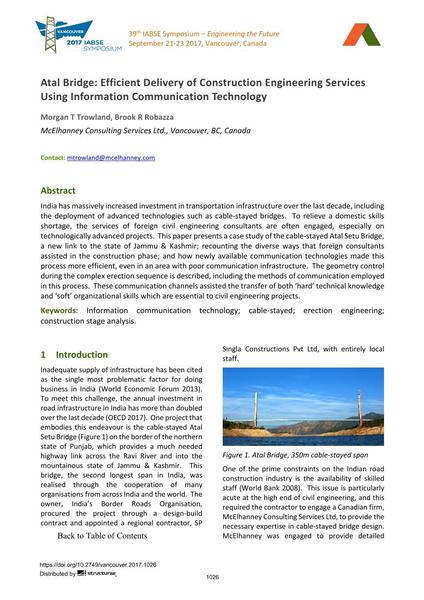Atal Bridge: Efficient Delivery of Construction Engineering Services Using Information Communication Technology

|
|
|||||||||||
Bibliografische Angaben
| Autor(en): |
Morgan T. Trowland
(McElhanney Consulting Services Ltd., Vancouver, BC, Canada)
Brook R. Robazza (McElhanney Consulting Services Ltd., Vancouver, BC, Canada) |
||||
|---|---|---|---|---|---|
| Medium: | Tagungsbeitrag | ||||
| Sprache(n): | Englisch | ||||
| Tagung: | IABSE Symposium: Engineering the Future, Vancouver, Canada, 21-23 September 2017 | ||||
| Veröffentlicht in: | IABSE Symposium Vancouver 2017 | ||||
|
|||||
| Seite(n): | 1026-1033 | ||||
| Anzahl der Seiten (im PDF): | 8 | ||||
| Jahr: | 2017 | ||||
| DOI: | 10.2749/vancouver.2017.1026 | ||||
| Abstrakt: |
India has massively increased investment in transportation infrastructure over the last decade, including the deployment of advanced technologies such as cable-stayed bridges. To relieve a domestic skills shortage, the services of foreign civil engineering consultants are often engaged, especially on technologically advanced projects. This paper presents a case study of the cable-stayed Atal Setu Bridge, a new link to the state of Jammu & Kashmir; recounting the diverse ways that foreign consultants assisted in the construction phase; and how newly available communication technologies made this process more efficient, even in an area with poor communication infrastructure. The geometry control during the complex erection sequence is described, including the methods of communication employed in this process. These communication channels assisted the transfer of both ‘hard’ technical knowledge and ‘soft’ organizational skills which are essential to civil engineering projects. |
||||
